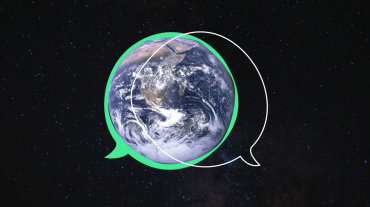5 surprising ways to reduce your carbon footprint
Within many daily decisions hides an opportunity to help the planet. Here are five surprising ways to squash your carbon footprint today.
Shaving. The messy byproduct of woodwork, and more commonly a verb for removing hair from skin, or meat from a rotisserie spit. It’s also a smart way to approach your carbon footprint. Shaving down your footprint through micro-decisions is like climbing into the shallow end of a sustainable lifestyle. It’s a painless, non-scary way to start getting serious about the environment. In this list, we’ll throw out five unexpected (and easy) ways to reduce your carbon footprint.
Video calling: heavy on data, and the environment
Ready for some numbers? Video calling for just one hour leaves a thumb-print on the environment: up to 1,000g of CO2, two to twelve liters of water, and a land mass roughly the size of an iPad. That’s the strange news. The good news is that you can flatten this environmental impact by 96%, just by turning your video off.
Video bloats the data weight of a call. To process all this extra information, providers need bigger servers, which use more energy. So, environmentally, you’re totally justified in leaving your camera off for your next video call. Let’s see what your boss or professor has to say about that.
Plastic: color matters
Black is beautiful. It’s slimming, sleeking (that’s a word — we checked), and makes everything around it look vibrant. Here’s the but, and you know it’s coming: it’s worse for the environment. Recycling usually involves automatic separation. Imagine a big, rattling machine that pings light off an item to identify what it is, and where to send it. Black absorbs light, meaning black items confuse the machine, which sulkily sends them straight to landfill.
While technology is slowly finding a workaround, sticking to white or clear plastic is a sure way to appease the recycling gods, and chip down your carbon footprint.
Milk: skimming your footprint
Imagine this. You’re sitting before a row of levers. They all do basically the same thing, but have different impacts on the environment. If you had to pull one, you would probably pick the one with the lightest impact, right? This happens every time you’re in the milk aisle of your supermarket. We’re not telling you what to do. Heck, our office fridge is a safe space for all milks, but there are clear environmental winners here. Check them out:

This isn’t the only environmental metric, mind you. Almond might create the least carbon, but dwarfs the others in water use (371 liters per liter of milk, compared to, say, 28 liters for soy milk). Be aware of what you’re buying, and what’s behind it.
If you’re sticking with cow milk and live near a dairy farm, consider getting it delivered. Not only will you score retro points, but it’s decisively better for the planet. Full marks if you buy from farms with electric delivery vehicles.
Conscious cleansing
Baths are like dessert. Indulgent and rewarding — one of life’s blisses. But like that dessert, having one every day is bad news. Not only for your skin, but it’s a real gut-punch for the environment. Even a modest bath of belly-button-high water uses an average of 75 liters, or 20 gallons. In comparison, showering for 10 minutes will use 50 liters, 20 with a water-saving nozzle.
Obviously, there are variables here. So make an informed decision. Taking an obscenely long and hot shower will kill its water-sparing benefits. And, if you’re reading this from the 19th century, you could even share bathwater with other people, which is an extreme but effective way to cut your footprint.
Food: spread it around
We understand the ‘optimistic’ approach to grocery shopping; buying what you think might be eaten. But if you constantly find yourself tipping food into the trash, herein lies an opportunity to cut your footprint. While you can't unbuy that food, you can donate it. Meaning that other people, normally less fortunate, don’t need to buy more.
Check your cupboards (that’s a larder, for you 19th century folk). Those emergency soup cans you bought years ago might make a decent meal for someone today. So consider hauling them and other non-perishables to your local food bank. You’ll be struck by how grateful they are. We’re not prescribing anything here, but food never eaten is food wasted.
Food banks, as a rule, don’t take food that isn’t commercially packed. We’ll let your imaginations decide why that is. But most big cities have thriving online communities where you can post items for trade (or donation). Got leftovers that you’re unlikely to finish? Let somebody pick them up.
🍲 Pro tip: if you’re posting leftovers on Facebook, tell people they can PM you. Some users don’t like replying publicly.
Joining these websites is a smart move to peck away at your carbon footprint and save money: they’re usually a warren of eco-friendly, bartering activity.
Offset the rest
Being environmental isn’t an ‘all-in’ plunge. You can start slowly, by adopting low-carbon habits that fit your lifestyle. But there’s a deeper message painted across this article: use less, reuse, and recycle. Basically every tip for reducing your personal carbon footprint hangs like a tendril from this philosophy.
And once you’ve squished your footprint to its bony minimum, Klima lets you offset the rest. Check out the most common myths about offsetting if you need to clear away any confusion on how offsets actually work.
Klima's diverse projects are verified at the highest level, promote the well-being of surrounding communities, and highly effective at removing or preventing emissions. This yin-yang approach of reduction and offsetting allows you to meaningfully reduce your personal carbon footprint, and play your part in healing the world.
Ready to get started? Simply download Klima and, in less than three minutes, you can erase 100% of your carbon footprint by supporting initiatives like the Mauritania solar project.


